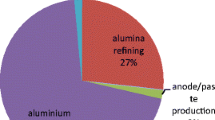Abstract
This paper addresses the global challenge of greenhouse gas emissions facing the aluminum industry. The demand, production and use of aluminum are increasing and so are the emissions. From bauxite mine to aluminum ingot, the total global average emissions vary somewhat in the literature, but most reported values are now between 12 and 17 metric tonnes of CO2-equivalents per tonne of aluminum, depending on the various estimates and assumptions made. Two-thirds of these gases are emitted because the electricity used for electrolysis is produced from fossil fuel sources, mainly coal but also natural gas. Reduction of these emissions is now the main environmental challenge for the aluminum industry. Globally, the best result is obtained by maximizing aluminum production using green electrical energy from renewable sources. Aluminum production is categorized as an activity at very high risk of carbon leakage, which occurs when there is an increase in carbon dioxide emissions by new production in one country as a result of ceased production with emissions reduction in a second country with a strict climate policy.




Similar content being viewed by others
Change history
24 January 2020
The authors note that figure
24 January 2020
The authors note that figure
References
World Aluminium, Current IAI Statistics (World Aluminium, 2019), https://www.world-aluminium.org/statistics/primary-aluminium-smelting-energy-intensity/#data. Accessed 30 Aug 2019.
Chris Bayliss, Light Metal Age 77, 38 (2019).
T. Bruckner, I.A. Bashmakov, Y. Mulugetta, H. Chum, A. de la Vega Navarro, J. Edmonds, A. Faaij, B. Fungtammasan, A. Garg, E. Hertwich, D. Honnery, D. Infield, M. Kainuma, S. Khennas, S. Kim, H.B. Nimir, K. Riahi, N. Strachan, R. Wiser, and X. Zhang, Energy systems.AR5 climate change 2014: mitigation of climate change: contribution of working group III to the fifth assessment report of the intergovernmental panel on climate change, ed. O. Edenhofer, R. Pichs-Madruga, Y. Sokona, E. Farahani, S. Kadner, K. Seyboth, A. Adler, I. Baum, S. Brunner, P. Eickemeier, B. Kriemann, J. Savolainen, S. von Schlömer, C. Stechow, T. Zwickel, and J.C. Minx (Cambridge: Cambridge University Press, 2014)
International Energy Agency, #ETP2017-scenario, Renewables (IEA, 2019), https://www.iea.org/topics/renewables/. Accessed 31 Aug 2019.
W. Haupin and H. Kvande, in Light Metals 2000, ed. by R.D. Peterson (New York, NY: Springer, 2000), p. 379.
H. Kvande and B. Welch, Light Metal Age 76, 28 (2018).
Alcoa Newsroom Media Release, Alcoa and Rio Tinto Announce World’s First Carbon-Free Aluminum Smelting Process, (Alcoa, Pittsburgh, 2018).
ELYSIS Exclusive, Aluminium Int. Today, 32, 8 (2019).
Asbjørn Solheim, Light Metals 2018, ed. O. Martin (New York, NY: Springer, 2018), p. 1253.
OECD Trade Policy Papers, Measuring distortions in international markets: the aluminium value chain (OECD Publishing, 2019), http://dx.doi.org/10.1787/c82911ab-en. Accessed 11 Sept 2019.
Media Release CRU, Understanding Where Future Aluminium Smelters will Develop (CRU, 2018), https://www.marketwatch.com/press-release/cru-understanding-where-future-aluminium-smelters-will-develop-2018-03-22. Accessed 11 Sept 2019.
O. Sartor, Cdc Climat Research Working Paper No. 2012-12 (CDC Climat, 2012), https://www.cdcclimat.com/IMG/pdf/12-02_cdc_climat_r_wp_12-12_carbon_leakage_eu_ets_aluminium.pdf. Accessed 11 Sept 2019.
European Commission, official website, Carbon leakage (EC, 2019), https://ec.europa.eu/clima/policies/ets/allowances/leakage_en. Accessed 1 April 2019.
European Commission, official website, EU-ETS Handbook (European Union, 2015), https://ec.europa.eu/info/index_en. Accessed 12 Sept 2019.
European Commission, Decisions to the Commission Delegated Decision supplementing Directive 2003/87/EC of the European Parliament and of the Council concerning the determination of sectors and subsectors deemed at risk of carbon leakage for the period 2021 to 2030, ANNEX (European Commission, 2019). https://eur-lex.europa.eu/legal-content/EN/TXT/?uri=CELEX:32019D0708. Accessed 12 Nov 2019.
European Commission, Commission Staff Working Document Impact Assessment (European Commission, 2015), https://ec.europa.eu/environment/archives/air/pdf/Impact_assessment_en.pdf. Accessed 11 Sept 2019.
J. Sijm, K. Neuhoff, and Y. Chen, Clim. Policy (2006). https://doi.org/10.1080/14693062.2006.9685588.
Pöyry, Carbon Transfer Factor in the Nordic Power Market, report to Norsk Industri (Ea Energy Analysis, 2012), Accessed 11 Sept 2019.
Landsvirkjun (LV, 2019), https://www.landsvirkjun.com/productsservices/valueproposition. Accessed 12 Nov 2019.
World Aluminium, Addendum to the Life Cycle Inventory Data and Environmental Metrics for the Primary Aluminium Industry, 2015 Data, Final August 2018 (World Aluminium, 2018), https://www.world-aluminium.org/media/filer_public/2018/09/20/addendum_to_lca_report_2015__aug_2018.pdf. Accessed 11 Sept 2019.
Official Journal of the European Union, DIRECTIVES, Directive (EU) 2018/410 of the European Parliament and of the Council of 14 March 2018 (European Union, 2018), https://eur-lex.europa.eu/legal-content/EN/TXT/PDF/?uri=CELEX:32018L0410&from=EN. Accessed 11 Sept 2019.
DIRECTIVE 2003/87/EC of the European Parliament and of the Council of 13 October 2003, https://eur-lex.europa.eu/LexUriServ/LexUriServ.do?uri=CONSLEG:2003L0087:20090625:EN:PDF.
European Commission, Report from the Commission to the European Parliament and the Council, Report on the functioning of the European carbon market (European Commission, 2018). https://ec.europa.eu/commission/sites/beta-political/files/report-functioning-carbon-market_en.pdf. Accessed 12 Nov 2019.
Government of India, Ministry of Power, CO2 Baseline Database for the Indian Power Sector, User Guide, June 2018, https://www.cea.nic.in/reports/others/thermal/tpece/cdm_co2/user_guide_ver13.pdf. Accessed 12 Nov 2019.
S. Healy, K. Schumacher, and W. Eichhammer, Energies (2018). https://doi.org/10.3390/en11051231.
World Aluminium Publications, A life-cycle model of Chinese grid power and its application to the life cycle impact assessment of primary aluminium (World Aluminium, 2017), https://www.world-aluminium.org/publications/tagged/life%20cycle/. Accessed 9 Sept 2019.
European Environment Agency, Overview of electricity production and use in Europe (EEA, 2019), https://www.eea.europa.eu/data-and-maps/indicators/overview-of-the-electricity-production-2/assessment-4. Accessed 11 Sept 2019.
NVE, Electricity Disclosure 2017 (NVE, 2019), https://www.nve.no/energy-market-and-regulation/retail-market/electricity-disclosure-2017/. Accessed 9 Sept 2019.
L. Kyzer, National Inventory Report, Emissions of Greenhouse Gases in Iceland from 1990 to 2016 (The Environment Agency of Iceland, 2018), https://www.icelandreview.com/tag/greenhouse-gases/. Accessed 11 Sept 2019. OK now.
A. Moro and L. Lonza, Transport. Res. Part D, 64 (Int. J. Life Cycle Assess 21 2016), 5-14, 2018: http://doi.org/10.1016/j.trd.2017.07.012.
Conference board of Canada, Low-emitting electricity Production, Provincial and Territorial Ranking, https://www.conferenceboard.ca/hcp/provincial/environment/low-emitting-electricity. Accessed 12 Nov 2019.
European Aluminium, EU Aluminium Imports Dependency, EU25 data for 2000-2004 and EU27 data for 2005-2015 (EA, 2019), https://www.european-aluminium.eu/data/economic-data/eu-aluminium-imports-dependency/. Accessed 8 April 2019.
Author information
Authors and Affiliations
Corresponding author
Additional information
Publisher's Note
Springer Nature remains neutral with regard to jurisdictional claims in published maps and institutional affiliations.
Halvor Kvande—emeritus professor at The Norwegian University of Science and Technology.
Rights and permissions
About this article
Cite this article
Saevarsdottir, G., Kvande, H. & Welch, B.J. Aluminum Production in the Times of Climate Change: The Global Challenge to Reduce the Carbon Footprint and Prevent Carbon Leakage. JOM 72, 296–308 (2020). https://doi.org/10.1007/s11837-019-03918-6
Received:
Accepted:
Published:
Issue Date:
DOI: https://doi.org/10.1007/s11837-019-03918-6




